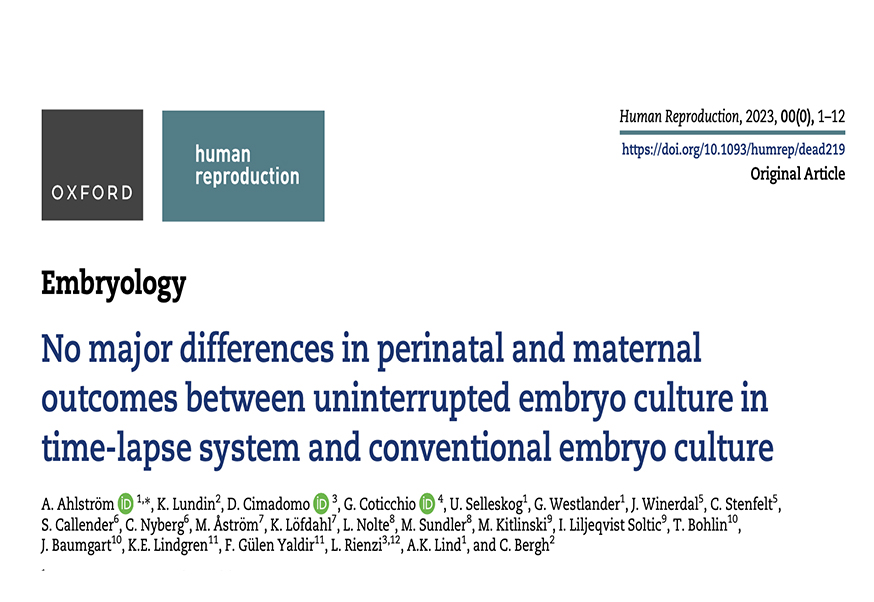
A. Ahlstrom, K. Lundin, D. Cimadomo, G. Coticchio, U. Selleskog, G. Westlander, J. Winerdal, C. Stenfelt, S. Callender, C. Nyberg, M. Åstrom, K. Lofdahl, L. Nolte, M. Sundler, M. Kitlinski, I. Liljeqvist Soltic, T. Bohlin,
J. Baumgart, K.E. Lindgren, F. Gulen Yaldir, L. Rienzi, A.K. Lind, and C. Bergh
Received: July 1, 2023. Revised: October 6, 2023. Editorial decision: October 11, 2023. Published: 25 October 2023
ABSTRACT
STUDY QUESTION: Is embryo culture in a closed time-lapse system associated with any differences in perinatal and maternal out-comes in comparison to conventional culture and spontaneous conception?
SUMMARY ANSWER: There were no significant differences between time-lapse and conventional embryo culture in preterm birth (PTB, <37 weeks), low birth weight (LBW, >2500 g) and hypertensive disorders of pregnancy for singleton deliveries, the primary out- comes of this study.
WHAT IS KNOWN ALREADY: Evidence from prospective trials evaluating the safety of time-lapse incubation for clinical use show similar embryo development rates, implantation rates, and ongoing pregnancy and live birth rates when compared to conventional incubation. Few studies have investigated if uninterrupted culture can alter risks of adverse perinatal outcomes presently associated with IVF when compared to conventional culture and spontaneous conceptions.
STUDY DESIGN, SIZE, DURATION: This study is a Swedish population-based retrospective registry study, including 7379 singleton deliveries after fresh embryo transfer between 2013 and 2018 from selected IVF clinics. Perinatal outcomes of singletons born from time-lapse-cultured embryos were compared to singletons from embryos cultured in conventional incubators and 71 300 singletons from spontaneous conceptions. Main perinatal outcomes included PTB and LBW. Main maternal outcomes included hypertensive disorders of pregnancy (pregnancy hypertension and preeclampsia).
PARTICIPANTS/MATERIALS, SETTING, METHODS: From nine IVF clinics, 2683 singletons born after fresh embryo transfer in a time- lapse system were compared to 4696 singletons born after culture in a conventional incubator and 71 300 singletons born after spon- taneous conception matched for year of birth, parity, and maternal age. Patient and treatment characteristics from IVF deliveries were cross-linked with the Swedish Medical Birth Register, Register of Birth Defects, National Patient Register and Statistics Sweden. Children born after sperm and oocyte donation cycles and after Preimplantation Genetic testing cycles were excluded. Odds ratio (OR) and adjusted OR were calculated, adjusting for relevant confounders.
MAIN RESULTS AND THE ROLE OF CHANCE: In the adjusted analyses, no significant differences were found for risk of PTB (adjusted OR 1.11, 95% CI 0.87–1.41) and LBW (adjusted OR 0.86, 95% CI 0.66–1.14) or hypertensive disorders of pregnancy; preeclampsia and hy- pertension (adjusted OR 0.99, 95% CI 0.67–1.45 and adjusted OR 0.98, 95% CI 0.62–1.53, respectively) between time-lapse and conven- tional incubation systems. A significantly increased risk of PTB (adjusted OR 1.31, 95% CI 1.08–1.60) and LBW (adjusted OR 1.36, 95% CI 1.08–1.72) was found for singletons born after time-lapse incubation compared to singletons born after spontaneous conceptions. In addition, a lower risk for pregnancy hypertension (adjusted OR 0.72 95% CI 0.53–0.99) but no significant difference for preeclampsia (adjusted OR 0.87, 95% CI 0.68–1.12) was found compared to spontaneous conceptions. Subgroup analyses showed that some risks were related to the day of embryo transfer, with more adverse outcomes after blastocyst transfer in comparison to cleavage stage transfer.